
Produced by the Light Rail Now! Publication Team
This news feature provides an ongoing Weblog of particularly significant developments in public transportation and rail transit.
10 December 2010
Dallas-area suburb plans unique station as DART light rail extension nears
Dallas Area Rapid Transit [DART] light rail trains are expected to be running to suburban Rowlett in 2012, and the suburban community's City Council has provided an extra $75,000 to get a unique, customized station.
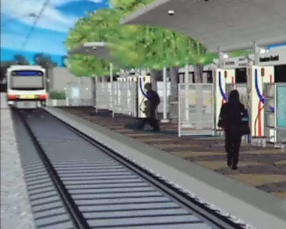 "The City of Rowlett's been looking toward the future for a long time," reported WFAA television (September 6th), "and it's now actually coming to fruition.
After paying into the DART system since 1983, the city has just seen final plans for its rail station."
"The City of Rowlett's been looking toward the future for a long time," reported WFAA television (September 6th), "and it's now actually coming to fruition.
After paying into the DART system since 1983, the city has just seen final plans for its rail station."
[Graphic: DART]
"I think it will be something that is completely unique" said Donna Davis, a Rowlett council member.
City leaders envision that when the station is complete, people will come from surrounding communities to catch a ride.
"I think you're going to see a lot of people coming here to catch the light rail to take them into Dallas and other parts of the metroplex" said Rowlett Mayor John Harper.
"And not only will they park here, we're expecting them to shop here" he added.
And, if all goes well, we'll entice them to move here."
According to the TV report, "With its proximity to the lake, a coming connection to the Bush Turnpike and plans for a DART rail station, the leaders of Rowlett say years of patient waiting are about to pay off."
In addition, "DART officials say construction to complete the Blue Line to Rowlett is on schedule and should be completed by late 2012."
Light Rail Now! NewsLog
URL: http://www.lightrailnow.org/news/n_newslog2010q4.htm#DAL_20101210
Updated 2010/12/10
More on Dallas Public Transport
More on Rail Transit Development...
4 November 2010
Tampa:
Light rail ballot initiative fails
The effort to kick-start a regional rail system for the Tampa area, using light rail transit (LRT) technology, and funded by a 1% sales tax, was rejected by nearly 60% of voters this past Tuesday (Nov. 2nd).
According to some proponents and opponents of the plan, a major factor in the defeat was the lack of a clear route and station plan.
As the Tampa Tribune explained in a November 2nd analysis,
>>
Until mid-August, HART had said it would provide voters with proposed light rail routes and stations before the referendum.
HART then said it needed more time to update first phase rail plans that had been extended this summer beyond the West Shore business district to and through the airport to the west and beyond Skipper Road and the University of South Florida to Cross Creek.
The decision – if not the rationale of delaying the route decision to just two weeks beyond the referendum – puzzled proponents and opponents alike.
HART had increased its consultant expenditures to about $1.3 million to devise plans to compete for federal matching funds to be ready by year's end, but proponents did not insist on finalizing plans before the election.
That seemingly provided ammunition to opponents of the tax, who said it made little sense to approve a tax to support a system whose details were undecided.
<<
The article does cite some problems that impeded the effort to adequately define project details. For example, says the paper, "... some supporters believed a 'fuzzier' plan would have better chance of passage by not excluding options before the vote."
Also, the paper notes, "The route decision also has been complicated by ongoing negotiations with CSX railroad to either run light rail alongside its track on 30th street or buy nearly 100 miles of track to gain access to the six mile portion HART sought to use in east Tampa."
In any event, the paper reports, "The outcome of Tuesday's referendum left unclear answers to the question of what's next with light rail and how to fund it now that the tax referendum."
However, predicts the Tribune, "What is certain is that the issue will not disappear in the near future."
Light Rail Now! NewsLog
URL: http://www.lightrailnow.org/news/n_newslog2010q4.htm#TAM_20101104
Updated 2010/11/04
More on Tampa Public Transport
More on Rail Transit Political Issues...
More on Rail Transit Political Campaigns...
2 November 2010
Norfolk launches multi-modal transportation center project
Norfolk, Virginia — A new multi-modal transportation center project is under way, just as the metro area's brand-new Tide light rail transit (LRT) system – slated to open for service in 2011 – heads toward completion.
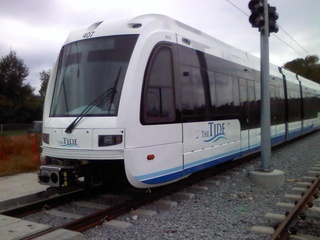 According to an August 30th report in Norfolk's Virginian-Pilot newspaper, the intermodal transportation hub, situated at Harbor Park downtownat Harbor Park downtown, will link up the LRT system, intercity passenger rail, buses, and other modes.
According to an August 30th report in Norfolk's Virginian-Pilot newspaper, the intermodal transportation hub, situated at Harbor Park downtownat Harbor Park downtown, will link up the LRT system, intercity passenger rail, buses, and other modes.
[Photo of Norfolk LRT car in testing: WAVY-TV]
Located on the site where Norfolk Union Station once stood, the transportation center is projected to cost $16 million in investment, to be partly covered by $6 million from the the city, which last has applied for the remaining $10 million in the form of federal stimulus money.
Later expansions, according to the newspaper report, would include a parking garage and mixed-use development surrounding the transportation center.
The rail passenger depot also would be expanded to accommodate a future higher speed rail link that the state has agreed to pursue for Norfolk.
"It's really about making seamless connections" noted Ray Amoruso, Hampton Roads Transit's senior vice president for planning.
"It's a very ambitious thing... it's like a big city" he added.
Rod Woolard, an assistant city manager, noted that the project is being designed in a modular way for ease of expansion.
As the Virginian-Pilot further reported,
>>
With the city's $6 million initial investment, a 2,400-square-foot Amtrak train station would be built.
The state has promised one train a day within three years to Richmond and beyond to Washington and Northeastern cities, which could grow to three trains a day.
In addition, a new bus transfer facility would be developed, moving about two-thirds of buses from the current location at Cedar Grove north of downtown on Monticello Avenue.
Covered walkways connecting the train, the buses and the Harbor Park light-rail station would be constructed.
It would be topped off with a "grand arrival plaza" facing Park Avenue for cars and some short-term parking and stopping lanes.
<<
Woolard said the new center would open when Amtrak starts running in 2013, but bus operations will likely move before then to support the LRT station.
The paper also reported other possibilities:
>>
If the city is successful in winning federal money, a new ferry landing and terminal station would be built that would accommodate HRT's current ferry service between Norfolk and Portsmouth, and possibly higher speed ferries that are now under study.
The grant money would also allow for a larger train station, additional lighting and utility work, landscaping, better pedestrian linkages and bike paths to connect to the Elizabeth River Trail.
Upgrades to the trail would also be made.
<<
Mayor Paul Fraim said he hopes the transportation center project will "lend some momentum for expanding the light-rail system because of the fact that you can take light rail to catch the passenger train."
This includes the possibility of extending light rail into the city of Virginia Beach.
"Our ability to link light rail and passenger rail with ferry service and bus service would be rather unique, I think" Mayor Fraim added.
As the Virginian-Pilot notes,
>>
Multi modal transportation centers are growing in popularity around the country as commuters look for alternatives to the car.
In Seattle, a multi modal center connects buses from four transit agencies, three types of rail, a future street car system and a bike commuting station.
<<
Linda Thielke, a spokeswoman for King County Metro Transit, told the Norfolk reporter that "Whatever we can do to leave the car at home is a good thing."
Assistant City Manager Woolard said that, while the transportation center in and of itself has value for the city, "we're also looking at it in the context of the type of development it would likely spur."
According to the newspaper report,
>>
For years, the city has been buying property between Harbor Park and Norfolk State University for redevelopment to better connect downtown to areas east, including the south Brambleton area and NSU.
Coincidentally, the transportation hub is next to where the historic Union Station stood from 1912 through 1963.
Harbor Park, the Norfolk Tides baseball stadium, is there now. At its peak, three railroads served the old Union Station terminal....
<<
"Whatever we do build we want to be sure it includes the present and the future that could include more trains and faster trains" Fraim declared.
"We hope it will in the future become a major transportation hub."
Light Rail Now! NewsLog
URL: http://www.lightrailnow.org/news/n_newslog2010q4.htm#NFK_20101102
Updated 2010/11/02
More on Norfolk Public Transport
More on Rail Transit Development...
30 October 2010
Tampa:
Newspaper backs light rail plan coming before voters
Even though voters won't have precise details on the costs and routes of a light rail transit (LRT) system, LRT is needed as part of a modern transportation system for the Tampa urban area, the Tampa Tribune says in an August 22nd editorial.
Cities of comparable size to Tampa are pleased in retrospect that LRT was built, even though all details were not necessarily firmed up the editorial notes.
"Transparency in government is essential, even when it's confusing" say the paper's editors, with a definite tone of finger-wagging against Hillsborough Area Regional Transit (HART), the region's major transit agency.
>>
And the way the county's bus agency is working through complex issues in public is definitely frustrating to many observers. Details about its plans to improve transit have been trickling out, yet Hillsborough Area Regional Transit (HART) has delayed the basic decision of where the first route would go. That might not be known until after the November election.
It is perplexing that HART has released cost estimates that appear precise, yet the agency cannot know today exactly what should be done, or exactly where. The public needs to remember that specifics such as operating and construction costs, travel times and ridership are educated guesses that will be refined as decisions are made.
<<
Despite these unknowns, says the paper, if a modern public transport system is to be installed, Tampa and Hillsborough County will have to take the lead.
>>
Of course, details matter, but let's be clear about the ballot question: Do the residents of Hillsborough want to increase the local sales tax by 1 cent per dollar, with a cap on major purchases, to raise enough money to begin building a modern transportation system?
The money will be used for rail, buses and roads. Plans are to link the major population and business centers, including in future years Brandon and South Tampa. No one can say today how those links will be made or along which exact routes.
Much is unknown, and nothing can be done to shed more light on the future. We don't know how fast the economy will grow, what the price of gasoline will be in five years, or how much a future Congress will subsidize local rail.
Regional transportation plans include a visionary link to surrounding counties. But who knows when or if those counties will tax themselves to join?
What seems certain is that a regional system won't get started until Hillsborough, the heart of the urban area, starts it.
<<
The paper then lists "other factors to keep in mind as you make your decision about the plan."
>>
Local gasoline taxes are not enough to keep existing roads repaired, much less expand buses and improve all the roads that need it, not to mention transit improvements.
• The Tampa area only gets a return of 63 cents per dollar on our federal taxes for transit. Until more projects are built that qualify for federal support, taxpayers here will continue helping other cities build rail systems. That means subsidizing our competitors for the best jobs and businesses.
• Even though HART's buses are increasingly popular, only 13 percent of the local population has access to frequent transit service. The new transit plan will provide frequent service to well over half of county residents.
• Cities similar to Tampa that have built light-rail lines seem glad they did, even if they didn't have all the specifics nailed down before the vote.
• Federal air quality rules are being tightened. As one of the largest metropolitan areas in the South, and one of the largest in the country without rail transit, the Tampa area needs to show how it plans to grow without greatly increasing emissions.
• Without a funded plan to limit emissions, federal highway money could be withheld, as it once was in Atlanta.
<<
"This area has delayed transit improvements for too long" says the editorial.
"But to jump to conclusions, or take shortcuts, could disqualify HART for the federal assistance essential to completing the project."
"If it were quick and easy it would have already been done" the editors conclude.
Light Rail Now! NewsLog
URL: http://www.lightrailnow.org/news/n_newslog2010q4.htm#TAM_20101030
Updated 2010/10/30
More on Tampa Public Transport...
More on Rail Transit Political Campaigns...
More on Rail Transit Political Issues...
More on Rail Transit Development...
24 October 2010
Tampa:
Mayor declares "BRT" is "not acceptable" — LRT is region's only rational choice
Tampa, Florida — As the Tampa area approaches the November 2nd national elections and a crucial ballot initiative for a light rail transit (LRT) system, Tampa Mayor Pam Iorio underscores that LRT is the region's only rational choice for major local transportation corridor improvements, while she also acknowledged that the Federal Transit Administration requires a study of alternative transit modes as a condition for funding.
As reported in the August 20th Tampa Tribune, Mayor Iorio also dismissed a "BRT" option:
"I'm not afraid to say it – bus rapid transit is not acceptable" she declared in an interview with Tribune editorial board.
"You tell us why Charlotte, N.C., Phoenix, Salt Lake City should have light rail and not Tampa."
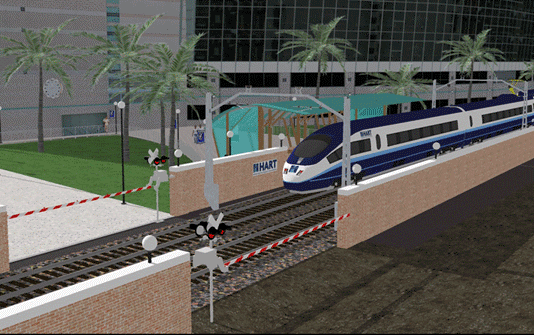 Simulation illustrates how LRT might look at a proposed Channelside station.
Simulation illustrates how LRT might look at a proposed Channelside station.
[Graphic: HART]
Iorio was mildly critical of Hillsborough County Area Regional Transit Authority (HART) officials, who, she said, could provide information but cannot advocate passage of the Nov. 2nd referendum to raise funds for transit and roads.
She said they had have done a good job with operational planning, but weren't so good at addressing political issues.
This criticism highlights HART's delays in planning, which have irritated supporters of the LRT proposal.
As the Tribune reports,
>>
The local movement to support a 1-cent on the dollar sales tax increase ran afoul of HART's announcement Monday that further refinement of light-rail ridership and cost data would delay HART's board from committing to precisely where the trains would run.
That means voters will not learn specific paths of light rail within two corridors – downtown to airport and downtown to New Tampa – before the referendum.
<<
In other words, voters apparently won't have any details – not even a route for the starter line – when they go to the polls to vote on the transit tax on Nov. 2nd.
(The map below shows the agency"s "conceptual" idea of what a system might look like.)
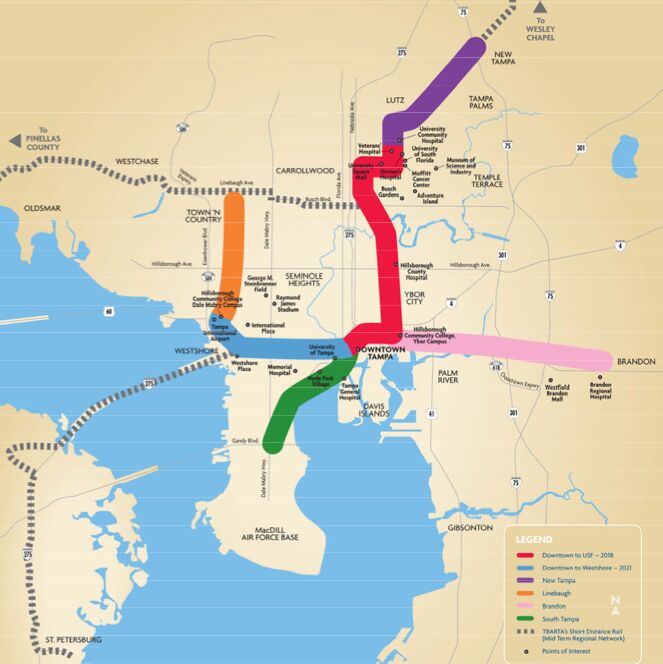
[Map: HART]
David Singer, a Holland & Knight attorney described as "leading the Moving Hillsborough Forward transit advocacy group", told the paper that the most significant issues in the transit proposal go well beyond just moving people from point to point.
"It's about economic development along the routes" Singer emphasized.
"It's not going to matter whether it's six blocks this way or six blocks that way."
According to HART CEO David Armijo, "Several national studies report higher land use redevelopment with light rail compared to bus rapid transit."
Mayor Iorio indicated some concern about promising more than could be delivered in the short term, mainly with respect to the metro area's northeast corridor, where two of the three alternatives under consideration involve concluding agreements with the CSX railroad company for right-of-way.
The mayor quipped that negotiating with CSX is like "negotiating with a nation state", citing the hard-line positions the freight railroad has assumed throughout its system when discussing deals for passenger rail operation.
But Iorio stressed that utilizing CSX rights of way on segments of the northeast corridor rather than along Interstate 275 would open substantially more economic development opportunities benefiting East Tampa neighborhoods.
Light Rail Now! NewsLog
URL: http://www.lightrailnow.org/news/n_newslog2010q4.htm#TAM_20101024
Updated 2010/10/24
More on Tampa Public Transport
More on Rail Transit Political Issues...
More on Rail Transit Political Campaigns...
More on Rail Transit Development...
18 October 2010
Cincinnati:
Casino revenues may help fund planned streetcar system
Could casino gambling revenues help fund Cincinnati's planned light rail streetcar system?
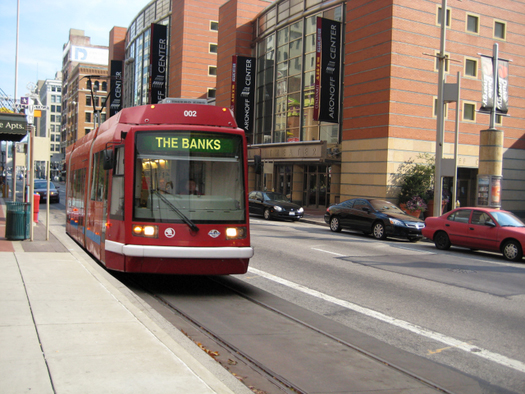 The September 30th issue of Business Courier of Cincinnati reports that some of the City of Cincinnati's share of revenues from a planned casino will be allocated to benefit the $128 million modern streetcar line which will pass several city blocks away from the gaming venue.
The September 30th issue of Business Courier of Cincinnati reports that some of the City of Cincinnati's share of revenues from a planned casino will be allocated to benefit the $128 million modern streetcar line which will pass several city blocks away from the gaming venue.
[Graphic of Cincinnati streetcar: Queen City Discovery]
A motion passed by the City council allocates spending from the approximately $20 million in projected casino revenue that the city expects to receive annually, after a Harrah's Entertainment property opens in 2013.
The motion stipulates that 15 percent of casino revenue will be used for economic development purposes, including the cost of operating Cincinnati's forthcoming streetcar system, according to the news report.
Light Rail Now! NewsLog
URL: http://www.lightrailnow.org/news/n_newslog2010q4.htm#CIN_20101018
Updated 2010/10/18
More on Cincinnati Public Transport
More on Rail Transit Development...
More on Streetcars...
2 October 2010
America's deepening economic crisis intensifies budget crisis in public transport industry
In a September 26th posting to his blog The Transport Politic, titled When the Recession Strikes, Little Maneuvering Room for Better Transit, Yonah Freeman highlights the growing crisis of America's public transportation industry.
This kind of analysis is quite important, because it brings the current near-universal crisis into proper perspective, and also rebuts transit opponents who try to seize on these difficulties to claim that it all proves that transit is a failure and, besides, transit management is basically a lot of corrupt, bureaucractic bunglers who "wste" money on expensive projects such as rail.
"The recession has not been kind to transportation agencies anywhere in the country" the analysis points out.
>>
The loss of local revenues from dedicated taxes has in many places required agencies to reduce bus and rail operations - even with the significant aid that accompanied the 2009 Stimulus bill. But long-term consequences have been even more problematic for the hundreds of expansion plans either under construction or planned; in metropolitan areas from Dallas to Denver, previously funded projects have been put on hold.
<<
As examples, Freeman discusses ites the cases of Seattle and Charlotte:
>>
Seattle's Sound Transit is the most recent to announce its own problems: Last week, the agency revealed that its fifteen-year estimates for revenue collection established just two years ago would be 25% lower than expected. This means that a once $18 billion proposal to extend the region's light rail system to the north, east, and south would have to be truncated by $3.9 billion, up from a $3.1 billion shortfall predicted just six months ago.
Though the region's construction programs already in construction and in advanced planning - University Link and East Link, respectively - remain on schedule, a further extension of light rail facilities south into South King County has been put on hold. A new transit investment in the region's northern corridor may no longer come in the form of light rail but instead in something less expensive, like improved buses. The creation of a new commuter rail link along the east side of the region has been suspended. All this in spite of the fact that Sound Transit has been able to literally quadruple ridership over the last ten years thanks both to the implementation of light rail beginning last year but also the improvement of regional bus and commuter rail services.
Seattle should comfort itself in the realization that despite all of these cutbacks, it is in a much better situation than cities elsewhere in the country. Example number one: Charlotte, whose countywide transit expansion program was revealed in the late 1990s and whose first light rail line has had high ridership, is facing a virtual shutdown in new construction because it has rightfully chosen to prioritize keeping its bus services afloat over spending on rail expansion.
<<
Freemark's analysis makes an interesting case for placing much of blame for the financial crunch on reliance on relatively volatile sales-tax-based revenue rather than on other more stable revenue sources:
>>
Most cities have been especially affected by the recession because of their reliance on the sales tax to provide revenue. Of the recent referendums on transit expansion programs, almost all have involved a 1/2 cent or one cent increase in that tax; few cities have looked to other forms of revenue, like an income tax or a payroll tax. The consequences of this decision, however, have been devastating because sales tax revenues have fallen considerably as a result of the recession and the reduced standard of living experienced by the majority of Americans over the past few years.
<<
As an alternative, Freemark cites his own previous financing recommendation, which he describes as "A more stable financing program for transit, using other forms of taxation, [that] would ensure that planned projects actually get built."
<>
Examining this further, Freeman's analysis discusses the challenges of pursuing revenue alternatives to sales tax funding:
>>
The practically universal reliance on the sales tax is a "realistic" response to the sense that it is the most politically palatable form of taxation available. Because municipalities and regional entities are interested in producing stable coalitions in favor of transit expansion, they are required to institute revenue devices that are both regressive and unstable. That's often because the business community - powerful in every area - is opposed to more progressive forms of taxation that threaten the salaries of their top executives. For many politicians, a sales tax is the most reasonable way to go about increasing funding. In addition, in many states, the idea of a special local or regional income tax is simply out of the question.
For cities like Seattle and Charlotte, what follows in an inability to proceed on schemes that were developed just a few years ago. But perhaps these cutbacks are simply the name of the game; it's not like an increase in revenue through an income tax is even much of a feasible possibility.
Thus the current enigma: Should cities that had large transit ambitions scale them back due to having less money than once expected, or should they push for new revenue sources? The first option could be difficult to reconcile in the eye of the average citizen who voted for a sales tax increase on the assumption that he or she would experience significant improvements in transit service as a result. The second option seems unlikely to be supported by voters who are being asked to pay twice for something they were told could be accomplished after the first tax alone.
<<
Finally, the analysis emphasizes the political dilemmas these revenue constraints are engendering for transit systems across the country:
>>
This situation puts transit agencies in a bind since they now appear as if they lied to the public when they promised certain amounts of spending during previous referenda. A more honest assessment of their travails would recognize that budget predictions are always predictions and nothing more; the severity of the recent recession was not something that was planned. Nonetheless, the public is rarely particularly sympathetic to the difficulties of government agencies.
<<
Light Rail Now! NewsLog
URL: http://www.lightrailnow.org/news/n_newslog2010q4.htm#USA_20101002
Updated 2010/10/02
More on Cost, Budget, & Financial Issues ...
More on Policy & Political Issues ...
Toward a "New Deal" for Public Transport ...
NewsLog for 2010: Jul.-Sep.
NewsLog for 2010: Apr.-Jun.
NewsLog for 2010: Jan.-Mar.
NewsLog for 2009: Oct.-Dec.
NewsLog for 2009: Jul.-Sep.
NewsLog for 2009: Apr.-Jun.
NewsLog for 2009: Jan.-Mar.
NewsLog for 2008: Oct.-Dec.
NewsLog for 2008: Jul.-Sep.
NewsLog for 2008: Apr.-Jun.
NewsLog for 2008: Jan.-Mar.
NewsLog for 2007: Oct.-Dec.
NewsLog for 2007: Jul.-Sep.
NewsLog for 2007: Apr.-Jun.
NewsLog for 2007: Jan.-Mar.
NewsLog for 2006: Oct.-Dec.
NewsLog for 2006: Jul.-Sep.
NewsLog for 2006: Apr.-Jun.
NewsLog for 2006: Jan.-Mar.
NewsLog for 2005: Oct.-Dec.
NewsLog for 2005: Jul.-Sep.
NewsLog for 2005: Apr.-Jun.
NewsLog for 2005: Jan.-Mar.
NewsLog Archives
Light Rail Now! website
| 